The Sonoran Desert stretches across Southern Arizona and Northern Sonora (Mexico). It is a hot, dry place. It is also the homeland for Indian people who call themselves O’odham.

The name O’odham means “we, the people.” The Spanish, the first European people to enter the area, called them Pimas Altos meaning Upper Pima Indians. The word Pima comes from the phrase pi-nyi-match (“I don’t know”) which was often the reply which the O’odham gave to the Spanish explorers.
The O’odham speak languages which are classified as Uto-Aztecan which means that they are linguistically related to other Indian nations such as the Hopi, the Ute, the Paiute, and the Shoshone, as well as many Indian nations in Mexico.
Today, there are two basic O’odham tribes: the Akimel O’odham (River People) who live along the Gila River and the Tohono O’odham (Desert People) who live to the south in what is now the Papago Reservation.
The Spanish, the American government and many non-Indian people have long used the name Papago in referring to the Tohono O’odham. Papago is from Papahvio-otam (“bean people”) which is the name given them by the neighboring Akimel O’odham.
According to the elders, the people have lived in the Sonoran Desert since they were created. One creation story says that Earthmaker scraped dirt from his chest and made it into a ball.
Then he stamped on it to flatten it out until it reached the edge of the sky. Then he made all of the things on the earth – the mountains, the rivers, the clouds, the animals, and the plants.
Earthmaker then made a small man with a beard and called him Eetoi. Earthmaker then made Coyote, a special being who could communicate with the supernatural. Using clay, Earthmaker then made people. The people were perfect and they did not die. However, there were too many people and soon they began fighting among themselves. Earthmaker and Eetoi then destroyed the people with a flood.
After the flood Earthmaker, Eetoi, and Coyote decided to create new people out of clay. To get just the right color, they baked the new people. Coyote’s batch was first and he burnt them black. The creators breathed life into them and then threw them away, far on the other side of the world. The second batch, made by Earthmaker, weren’t cooked long enough and they were white. The creators breathed life into them and threw them away, across the sea. The third batch, made by Eetoi, were baked nice and brown. The creators breathed life into the people and they stayed in the land where they had been created. Earthmaker gave Eetoi the title of Elder Brother.
Eetoi lives in a cave in the Baboquivari Mountains which are located southwest of Tucson, Arizona. When the people need him, that is where they find him.
Archaeologists tell us that the O’odham are the descendents of the Hohokam who were farming in the Phoenix area and along the rivers in southern Arizona more than a thousand years ago.
The homeland of the O’odham people was first claimed by the Spanish under the European concept of discovery which states that Christians have the right to claim and govern all non-Christian nations. In 1821, O’odham land became a part of Mexico and under the Mexican constitution they became Mexican citizens. In 1854, the United States bought much of the O’odham territory from Mexico. The O’odham were neither consulted nor told about this sale. Under American law, the O’odham lost their citizenship. Many of the O’odham simply ignored American jurisdiction and continued to claim their Mexican citizenship.
The United States did not purchase all of the O’odham territory from Mexico. As a consequence, the O’odham, like a number of other Indian nations, has to contend with an international border which divides its people. While most O’odham today live in the United States, there are still many O’odham who live in the Mexican state of Sonora.
Without negotiating a treaty with the O’odham or consulting with them, the United States simply extended federal Indian policy to them. In 1857 the government appointed the first Indian agent for them.
The Tohono O’odham and the Akimel O’odham have never been at war with the United States, nor has the United States ever negotiated a treaty with them. From the very beginning of the American occupation, O’odham warriors helped the army in their battles against the Apache. From the O’odham viewpoint, the Apache were traditional enemies who had been raiding into O’odham territory for a long time. The American army, therefore, was a convenient ally to help the O’odham stop the Apache raids.
The first Papago or Tohono O’odham reservation was unofficially created in 1864 when a two square league area around the Mission San Xavier del Bac was set aside for their exclusive use. The area was officially placed under the jurisdiction of the Indian agent in 1874.
In 1912, President William Howard Taft issued an executive order creating the 47,600 acre Ak-Chin reservation in Arizona. The reservation was created in part in gratitude to the O’odham for their help in the wars against the Apache in the late 1800’s.
With the creation of the Ak-Chin Reservation, the Bureau of Indian Affairs filed for a water appropriation on behalf of the Ak-Chin Indian Community which called for a total of 70,000 acre-feet annually. Non-Indians in the area were upset about the size of the reservation and about the water appropriation. Within four months of the original executive order, President Taft issued a second executive order which reduced the size of the reservation to 21,840 acres.
In 1916, President Woodrow Wilson issued an executive order to create the 3.1 million acre Papago Reservation for the Tohono O’odham. The town of Indian Wells was renamed Sells after Indian Commissioner Cato Sells and became the headquarters for the new Indian agency. The creation of the reservation was opposed by the Tucson Chamber of Commerce, the Arizona state land commissioner, and the Pima Farm Improvement Association. On the other hand, many non-Indian cotton growers favored the establishment of the reservation. Since the cotton growers needed seasonal labor, frequency supplied by the O’odham, having the reservation provided a convenient place for these laborers during the eight or nine months when they were not needed in the cotton fields.
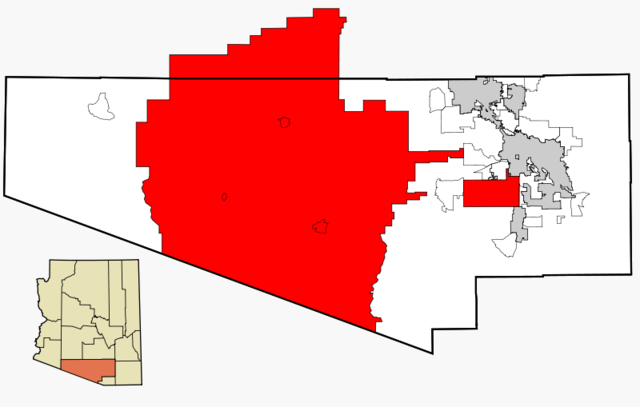
The reservation is marked in red in the map shown above.
The Tohono O’odham Indian Reservation (formerly called the Papago Reservation) located south and west of Tucson in southern Arizona is the second largest Indian reservation in the United States. It is about the size of the state of West Virginia. The boundary line for the reservation, however, excluded the eastern slope of Boboquivari Mountain, one of the most sacred areas for the O’odham.
Lots of people seem to think that Indians didn’t know about alcohol until the Europeans brought it to this continent. However, the Tohono O’odham were making an alcoholic ceremonial drink from the fruit of the saguaro cactus long before Europeans even knew that this continent existed. Called tiswin, it is drunk in conjunction with a rain ceremony-the Náwai’t. The Náwai’t ceremony includes ritual Mocking Bird speeches, songs taught to them by the supernatural being I’itoiI which bring the clouds down. During the ceremony the people make themselves drunk, much like the plants in the rain. The consumption of large amounts of tiswin results in vomiting, a recognized ceremonial feature which is called “throwing up the clouds.”
In 1922, the Tohono O’Odham held Náwai’t ceremonies which included the ritual consumption of tiswin to break an extended drought. The Bureau of Indian Affairs had the agency police raid the villages of Big Fields and Santa Rosa where several hundred participants were dispersed. The police arrested several leaders and Keepers of the Smoke for making tiswin. While the Bureau of Indian Affairs continued to warn people about this ceremony, the Tohono O’Odham continued to hold the ceremony in secret.
There are a lot of people, including some eminent historians, who seem to think that the last military battle against Indians took place in 1890 at a place called Wounded Knee on the Pine Ridge Reservation of the Oglala Sioux in South Dakota. In fact, the American army continued its war against Indians through the rest of the nineteenth century and the twentieth century. While the Tohono O’odham have always been friendly toward the Americans, there have been a few skirmishes. One of the most interesting of these skirmishes took place in the 1940s.
The basis for these skirmishes began in 1924 when the United States Congress passed legislation giving all Indians full American citizenship. This was done without consulting with Indian people. In 1940, the United States Congress passed another bill giving Indians citizenship. While many states, including Arizona, simply ignored both citizenship bills and denied Indians the rights of citizenship, the United States government insisted that as citizens Indians must register for the draft. In 1940, at the Tohono O’odham village of Toapit, 30 men under the leadership of Pia Machita refused to register for the draft. Marshals and Indian police attempted to arrest the leader, but they were roughed up and forced to release the 84 year old Machita. The Tohono O’odham then escaped into the desert. Pia Machita eluded the American army and federal marshals until 1941.
Oral tradition among the Tohono O’odham tells of army planes bombing villages during this time in an attempt to capture the draft rebels. The army’s unofficial story, again told as oral tradition, is that they were not bombing the villages, only dropping flour sacks on them to mark them so that they could be found from the ground.
Culturally, the O’odham don’t fit the common stereotypes of Indians who lived in tipis and hunted buffalo. Instead of tipis, the O’odham lived in dome- shaped lodges made from a framework of saplings and thatched with grass and/or leafy shrubs. These lodges were 12 to 20 feet in diameter. In addition to this lodge, they also built ramadas to provide them shade. These ramadas – which are still commonly used – provided an outdoor living and cooking space.
While the Plains Indians kept a Winter Count which recorded their history on skins, the O’odham kept calendar sticks. These sticks contained a notch for each year and then markings to show the events for the year. The calendar sticks are considered to be personal rather than tribal and so they are traditionally destroyed when the person keeping them dies. Most anthropologists consider the calendar sticks to be mnemonic devices (which help the owner remember the events) rather than a form of writing.
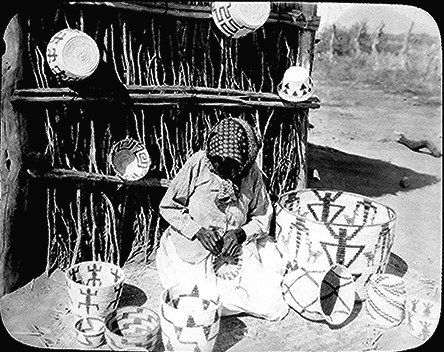
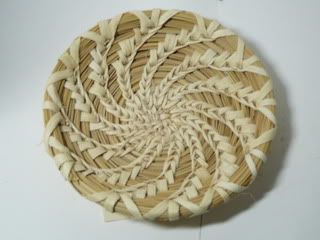
With regard to arts, the O’odham have gained a reputation for their fine basketry. The first evidence of the commercialization of O’odham basketry was seen in 1900 when the basketweavers began incorporating yucca into their baskets. Yucca is scarce and is used only in baskets which are intended to be sold to outsiders. In addition, they began making coiled baskets for the tourist market. These coiled baskets were easier to make than their traditional “tree” or plaited baskets.
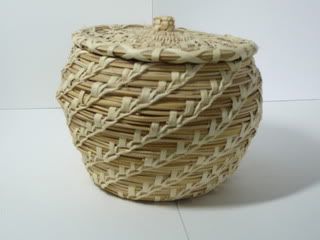
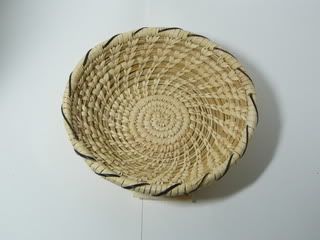
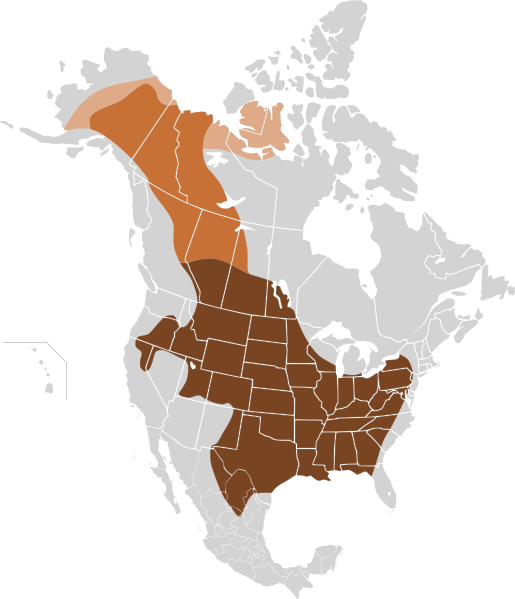
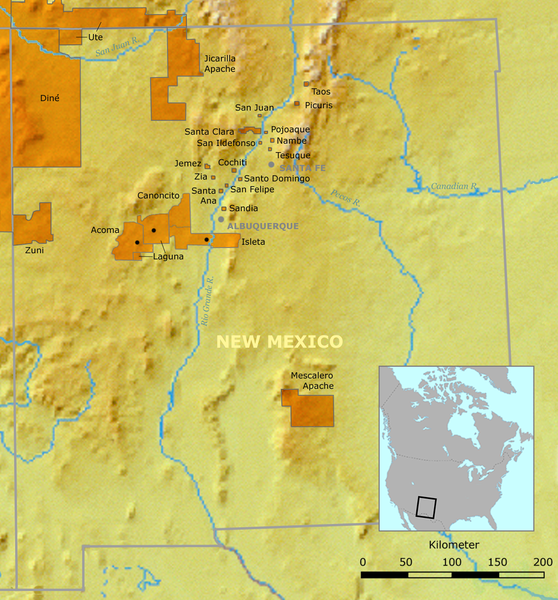
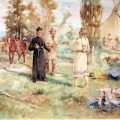
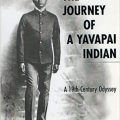
The Tohono O’odham are a group of Native American people who reside primarily in the Sonoran Desert of the southeastern Arizona and northwest Mexico.The O’odham way of life is based on the land that has held the remains of our ancestors since the creation of this world.